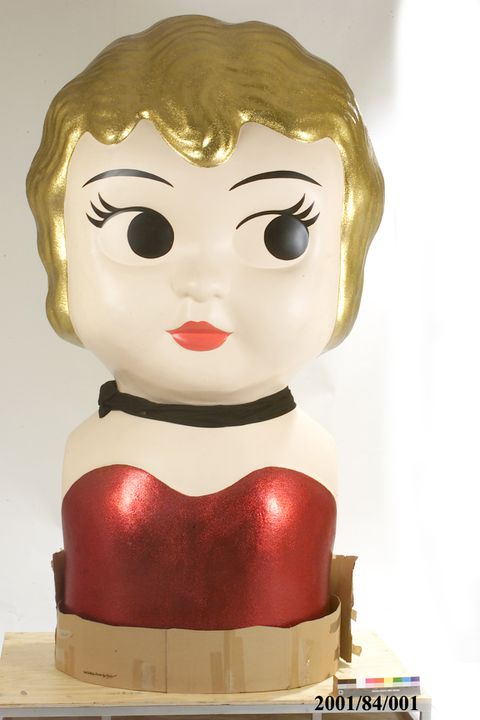Mounted on a steel-base trolley, this over-sized kewpie doll was one of twelve to feature in ‘Love Is In the Air’, a musical segment in the Closing Ceremony of the Sydney Olympic Games. Designed by Brian Thomson, the kewpie dolls’ heads and bodies were cast in fibreglass from polystyrene moulds. The crinoline and tulle skirts were enforced with concentric, fibreglass rods to prevent the fabric from catching under the trolley wheels. Each doll wore a different coloured dress with the skirts and glittered edges matching their painted bodices.
The closing ceremony of the Sydney 2000 Olympic Games took place on Sunday 1 October at Stadium Australia, Homebush Bay. It was conducted with decorum until the extinction of the Olympic flame, and then a party was unleashed. The giant kewpie dolls appeared on the arena shortly after the start of the ‘Let’s Party’ segment, when the ceremony erupted into life. The artistic director of the closing ceremony David Atkins explained ‘The athletes have finished competition, and are ready to party, and we have set about creating a party to end all parties. We have decided to invite everyone into our giant Australian backyard - fully equipped with Hills Hoists, barbecues, an eclectic mix of music, performers and all manner of Australiana. Australians have a tradition of throwing great parties, and this one will be imbued with a sense of fun, larrikinism and goodwill.’
According to Ric Birch (speaking on Channel 7’s ‘Olympic Sunrise’), the opening ceremony was to represent Australia at large, but the closing ceremony was Sydney’s show. Each kewpie doll was known to the prop makers by name - this one was referred to as ‘Scarlet’.
After Vanessa Amorosi’s performance of ‘Absolutely Everybody’, the arena was transformed into a huge dance-floor as 960 ballroom dancing couples in fluorescent costumes danced the samba, tango and jive to the beat of John Paul Young singing ‘Love is in the Air’. Although there was no direct allusion to the film ‘Strictly Ballroom’, the link was implied. The dancers were accompanied by 208 giant dancing feet and the incongruous assembly of oversized kewpie dolls while in mid-field the athletes formed a huge conga line. The dolls evoked old-time fairground fun but more specifically alluded to Ray Lawler’s 1955 play ‘The Summer of the Seventeenth Doll’ which uses kewpie dolls as not just theatrical props but as a metaphor for the illusionary nature of Olive’s relationship with Roo. Roo is her de facto partner who lives in Queensland seven months of the year and each time he visits he brings another doll. The dolls act as Olive’s surrogate children, revealing her innocent and unrealistic nature and carrying the connotation of fun, fantasy and childhood naivety. The dolls reflect the nature of their relationship, and through this Lawler comments on the changing state of morality in Australian society at the time.
As the ceremony unfolded the proliferation of suburban images such as Hills Hoists, blowflies, lifesavers and thongs was treated with self- deprecating irony rather than cliche. The wit and quality of the ‘Parade of Icons’ showed the influence of the late Peter Tully as artistic director of the Mardi Gras in, for example, the ‘pit chicks’ in silver hot pants who carried the eyelashes, stiletto shoes and giant mascara for the Priscilla bus.
The opening ceremony told a mythic story of nation-building that dwarfed individuals. It was evocative and subtle. The closing ceremony, however, celebrated personality, celebrity and attitude. Loud and brash, more like a rock concert than a profoundly theatrical event, it was an extravagant send-off — fun, festive, shamelessly excessive and, for an international audience, decidedly weird.
Kewpie dolls originated in 1909 in the American Ladies’ Home Journal magazine, where Rose O’Neill wrote children’s poems and made illustrations of characters which would become kewpies. Her cartoon drawings evolved into paper doll versions and then into unglazed ceramic items which gained popularity. Named after its resemblance to Cupid, a kewpie doll had big cheeks, wide-eyes, webbed hands, a tuft of hair and a round tummy.
Initially Rose O’Neil developed a series of the dolls, each with their own names and personalities and four years after their creation more than five million had been sold. With the coming of World War I, she stopped writing stories about kewpies but brought them back in 1925. The dolls regained popularity as prizes and giveaways at fairground sideshows. Kewpies were copied all over the world. In 1949, Effanbee created the first hard plastic kewpie dolls.
Article for The Powerhouse Museum Website here: https://collection.maas.museum/object/10743


